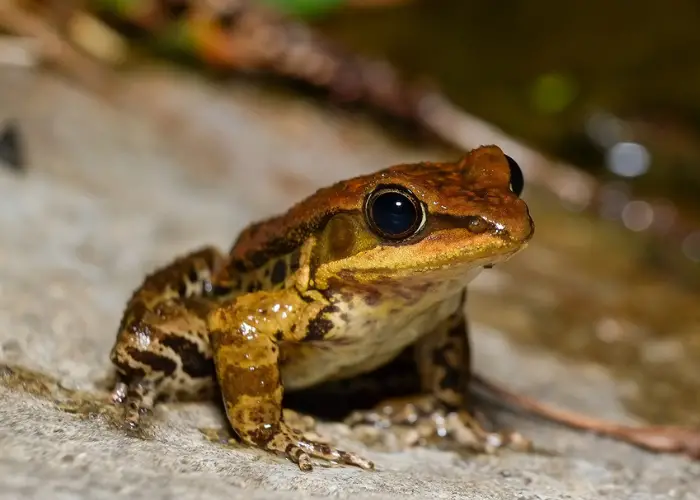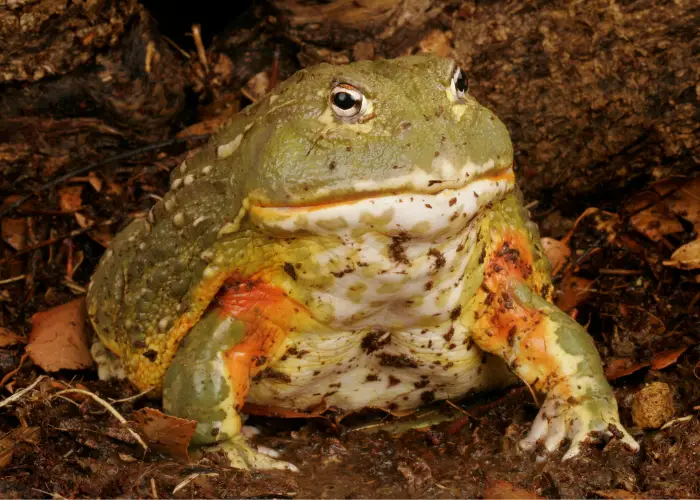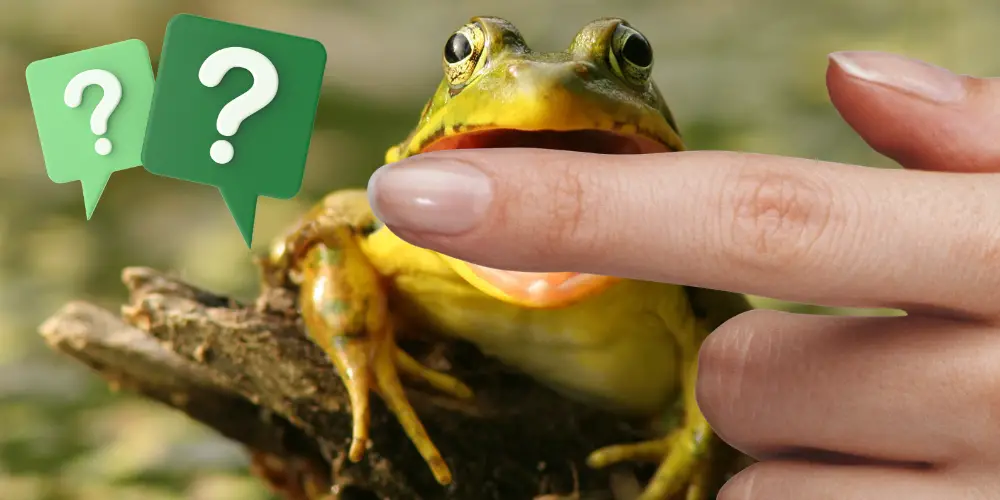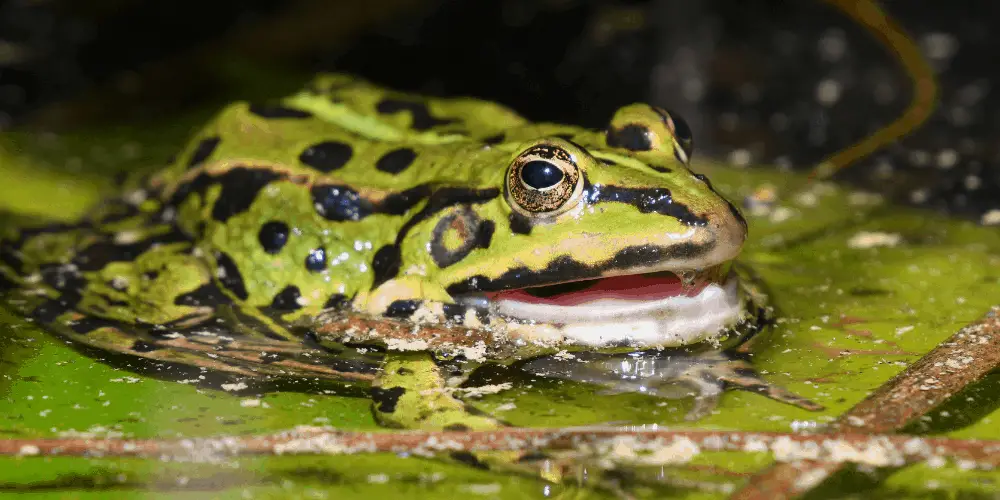“Do frogs bite?” It’s a question many curious minds have pondered.
Frogs can bite, but most species have small teeth that do not harm humans. Some larger species, such as the Pacman frog, have stronger jaws and can deliver a painful bite. Additionally, some frog species secrete toxins through their skin, so washing your hands after handling them is important.
Dive into this article to uncover the fascinating world of frogs, their behaviors, and why that occasional nip might be a frog’s way of saying “hello” or “back off!”
With intriguing facts and insights, you’ll hop away with a newfound appreciation for these amphibious wonders.
Key Takeaways
- Frogs can bite, but most species have small, non-harmful teeth.
- Larger species, like the Pacman frog, can deliver a painful bite.
- Some frogs secrete toxins through their skin, necessitating hand washing after handling.
- Frog behaviors range from instinctual actions to learned responses.
- Frogs communicate using various vocalizations, including croaks and chirps.
- Biting can be a defense mechanism, a response to mistaken identity, or due to stress.
- Most frog bites feel like a gentle pinch and are rarely harmful.
- Certain frog species, such as the African Bullfrog and Pacman Frog, are more prone to biting.
- Immediate response to a frog bite should include cleaning the area and applying antiseptic.
- Safe frog handling involves understanding their behavior, washing hands, and gently griping.
- Handling frogs requires respect, knowledge, and awareness of their signals and needs.
Understanding Frog Behavior

Frogs, with their diverse habitats and lifestyles, exhibit many behaviors that are both intriguing and essential for survival.
In the wild, these amphibians have evolved to adapt to various challenges, from evading predators to hunting for food.
Their behaviors are often a blend of instinctual actions and learned responses.
For instance, a frog extending its long, sticky tongue to catch an insect is an innate hunting behavior.
On the other hand, some frogs have learned to recognize the sound of approaching danger, such as the footsteps of larger animals, and will leap into the water or hide in the underbrush for safety.
One of the most captivating aspects of frog behavior is their communication.
Frogs “talk” to each other using a series of croaks, chirps, and other vocalizations.
These calls can signify anything from attracting a mate during the breeding season to staking out territory.
But what about biting?
Is it a typical behavior, or is it an exception?
And what might provoke a frog to bite?
As we delve deeper, we’ll explore the circumstances and reasons behind why a frog might need to use its mouth in defense or out of curiosity.
Do Frogs Really Bite?

When we think of creatures that bite, frogs might not be the first to come to mind.
However, the reality is that while frogs are generally not aggressive towards humans, they can bite.
But why would they?
Firstly, it’s essential to understand the difference between a genuine bite and a mere nip.
A bite is often more forceful and is typically a frog’s way of defending itself or asserting dominance.
Conversely, a nip can be a curious frog mistaking a finger for food or simply trying to get a grip.
Many misconceptions surround frog bites. Some believe all frogs are venomous or bite can transmit diseases.
While a few species of frogs carry toxins, most are harmless to humans. The anatomy of a frog’s mouth is quite fascinating.
Frogs don’t have sharp teeth designed for tearing or chewing unlike many animals. Instead, they have small, cone-shaped teeth used mainly for holding onto prey.
In the grand scheme, a bite from the most common frog species is unlikely to cause significant harm.
However, understanding the reasons behind a frog’s decision to bite and its mouth’s capabilities can offer insights into these amphibians’ intriguing world.
Reasons Why a Frog Might Bite

Frogs, like all creatures, have reasons for their actions. In comparison, a bite from a frog might come as a surprise to many.
Understanding the motivations behind such behavior can offer valuable insights into their world. Here are some reasons why a frog might decide to bite:
- Defense Mechanism Against Predators: Frogs face numerous threats in the wild, from birds and snakes to larger amphibians and mammals. A bite can serve as a last-resort defense mechanism when escape isn’t an option.
- Mistaking Fingers for Food: Frogs have a keen sense of movement, which they rely on to catch prey. A wiggling finger can easily be mistaken for a wriggling worm or insect, leading to an accidental bite.
- Mating Rituals and Territorial Disputes: Male frogs can become particularly aggressive during mating season. They might bite other males to assert dominance and secure a mate. Similarly, if another frog invades their territory, a bite can serve as a warning to back off.
- Stress or Feeling Threatened: Just like humans, frogs can feel stressed. A sudden change in their environment, being handled too frequently, or feeling cornered can lead to stress. A stressed frog is more likely to bite to protect itself.
- Curiosity: Younger frogs might bite out of sheer curiosity, especially those in captivity. They’re still exploring their environment and understanding their boundaries.
- Health Issues: A frog might bite due to underlying health issues or discomfort. For instance, if they have a skin infection or other ailment, they might be more irritable and prone to biting.
While a frog’s bite might be startling, it’s essential to remember that they don’t bite without reason.
Recognizing the signs and understanding the motivations can help ensure harmonious interactions with these fascinating amphibians.
What Does a Frog Bite Feel Like?

For those who’ve never experienced a frog bite, the sensation can be a topic of curiosity.
While the feeling can vary depending on the frog species and the individual’s pain threshold, here’s a general idea of what one might expect:
- A Gentle Pinch: Most frog bites can be likened to a light pinch. Given that most frogs have small, cone-shaped teeth designed more for gripping than tearing, the sensation is often mild.
- Personal Anecdotes: “I was once nipped by a tree frog while trying to feed it,” shares Lucy, a frog enthusiast. “It felt like a quick pinch, similar to getting snapped by a small rubber band. More surprising than painful!”
- Comparisons: If you’ve ever been pricked by a thorn or caught in a light pinch between playful fingers, that’s close to what a typical frog bite might feel like. However, larger species with a stronger bite might feel like a firm press without the sharp pain associated with bites from animals with pronounced teeth.
- Duration: The sensation of a frog bite is usually fleeting. While the initial surprise might cause a momentary sting, the discomfort often subsides quickly.
- Aftereffects: For most, a frog bite leaves no lasting mark. However, some might notice a slight redness or minor swelling, especially if there’s a reaction to any substances on the frog’s skin. Washing the area with soap and water after any animal bite is always a good idea.
A frog bite might be an unexpected experience, but it’s rarely a cause for concern.
The sensation is generally mild, and with understanding and care, such encounters can be minimized or even become a fun anecdote to share among fellow frog lovers.
Which Frog Species Are More Likely to Bite?

The world of frogs is vast and varied, with each species having unique behaviors and characteristics.
While many frogs are docile and shy away from confrontation, a few have earned a reputation for being more assertive or aggressive.
- African Bullfrog: Known for its impressive size, it is one species that doesn’t hesitate to bite if it feels threatened or cornered. With a robust and muscular build, its bite can be quite forceful, especially if it perceives a potential threat.
- Pacman Frogs: These frogs, named for their large mouths and round appearance reminiscent of the video game character, are notorious for their aggressive nature. They won’t hesitate to bite if they mistake movement for food or feel threatened.
- Budgett’s Frog: Often referred to as the “parrot frog” because of its broad mouth and flattened head, the Budgett’s can deliver a surprising nip if it feels provoked.
- Giant Monkey Frog: Native to the Amazon rainforest, this frog has a strong bite and is primarily used in the wild to catch larger prey.
While size can sometimes indicate a frog’s biting capability, it’s not always the rule.
Some smaller frogs can be just as assertive, while larger species might be more docile.
It’s also worth noting that individual frogs can have varying temperaments, even within a particular species.
Some might be more inclined to bite due to past experiences or their environment, while others might be more laid-back.
Understanding the nature and behavior of different frog species can help enthusiasts and researchers approach and handle them with the respect and caution they deserve.
Treating and Preventing Frog Bites

While frog bites are generally not severe, it’s essential to know how to treat them and take preventive measures to avoid future incidents. Here’s a comprehensive guide on addressing and preventing frog bites:
1. Immediate Response: The first step is to remain calm if bitten. Quickly but gently place the frog back in its habitat or safe space to prevent further stress for you and the amphibian.
2. Clean the Area: Wash the bitten area with mild soap and warm water. This helps to remove any potential irritants from the frog’s skin and reduces the risk of infection.
3. Apply Antiseptic: Apply an antiseptic solution or cream to the bite after cleaning. This further ensures that the area remains free from infection.
4. Observe for Reactions: While most frog bites are harmless, it’s essential to monitor the area for any signs of allergic reactions, such as excessive swelling, redness, or itching. If any of these symptoms persist, seeking medical attention is advisable.
5. Avoid Touching Face and Eyes: After handling a frog or treating a bite, avoid touching your face, especially your eyes, until you’ve thoroughly washed your hands. Some frogs secrete substances that can be irritating.
6. Educate on Safe Handling: Prevention is the best cure. Ensure that anyone interacting with the frog knows how to handle it safely and understands the signs that it might be stressed or agitated.
7. Recognize Stress Signs: Frogs puffing up, trying to escape, or showing vibrant color changes might signal distress. Recognizing these signs can help prevent potential bites.
8. Use Feeding Tools: If you’ve been bitten during feeding time, use tools like tweezers or forceps to offer food. This minimizes the frog’s risk of mistaking your fingers for a tasty treat.
9. Create a Safe Environment: Ensure the frog’s habitat is comfortable and stress-free. A content frog is less likely to bite.
10. Seek Expert Advice: If you’re unsure about your frog’s behavior or how to handle it, seek advice from herpetologists or experts in amphibian care.
In conclusion, while frog bites are rare and typically not severe, understanding how to treat and prevent them ensures a harmonious relationship with these captivating creatures.
How to Handle Frogs Safely

Handling frogs requires a gentle touch and an understanding of their behavior.
These delicate creatures can quickly become stressed or injured if not approached with care. Here’s a guide on how to interact with frogs safely and respectfully:
1. Do Your Research: Knowing its species and specific needs is essential before handling any frog. Some frogs might have skin toxins, while others might be more prone to stress.
2. Wash Your Hands: Always wash your hands before and after handling a frog. Clean hands ensure you don’t transfer harmful substances to the frog, and washing afterward protects you from any potential irritants from the frog’s skin.
3. Approach Calmly: Quick movements can startle frogs. Approach them slowly and calmly to minimize stress.
4. Gentle Grip: Use a soft grip when picking up a frog. Avoid squeezing or holding too tightly. Ideally, let the frog rest on your palm with fingers gently curled around its sides.
5. Limit Handling Time: Frogs can become stressed if handled for extended periods. Keep interactions brief and return the frog to its environment or enclosure promptly.
6. Be Mindful of Their Environment: If you’re observing frogs in the wild, be conscious of their habitat. Avoid disturbing their surroundings or causing any unnecessary stress.
7. Avoid Handling During Shedding: Frogs periodically shed their skin. It’s best to avoid handling them during this time as they can be more sensitive.
8. Understand Defensive Behaviors: If a frog puffs up, tries to leap away, or shows signs of distress, it’s a signal to give it space.
9. Educate Others: If you’re with friends or family, teach them how to handle properly and respect frogs. This ensures the safety of both the frog and the person.
Handling frogs is a privilege that comes with responsibility. Understanding and respecting their needs ensures that our interactions with these fascinating creatures are positive and enriching for both parties.
Final Thoughts

Frogs, with their diverse species and intriguing behaviors, have long captivated the hearts of many.
The question, “Do frogs bite?” has been explored in depth, revealing that while some frogs might nip or bite, it’s often a response to specific stimuli or situations.
Understanding the reasons behind these behaviors, from defense mechanisms to simple curiosity, offers a deeper appreciation for these amphibians.
It’s essential to approach frogs with respect and knowledge, recognizing their signals and ensuring their well-being.
By doing so, we can foster a positive relationship with these creatures, celebrating their role in our ecosystems and their unique characteristics.
We invite all our readers to dive deeper into the world of frogs, exploring their habitats, behaviors, and the myriad of species that grace our planet.
And for those who’ve had froggy encounters, we’d love to hear your stories and experiences.
Share them in the comments below, and let’s continue the conversation about these fascinating creatures!
STILL CROAKING FOR MORE FROG TOPICS?
- Why Do Frogs Scream?
- Do Bullfrogs Sleep?
- Do Frogs Have Tails? The Tale Behind the Tail
- Can Frogs Drown? [ Diving into Froggy Facts ]
REFERENCES:
- African bullfrog. (2023, August 10). In Wikipedia. https://en.wikipedia.org/wiki/African_bullfrog
- Ceratophrys. (2023, August 9). In Wikipedia. https://en.wikipedia.org/wiki/Ceratophrys
- Lepidobatrachus. (2023, July 31). In Wikipedia. https://en.wikipedia.org/wiki/Lepidobatrachus
- Phyllomedusa bicolor. (2022, November 26). In Wikipedia. https://en.wikipedia.org/wiki/Phyllomedusa_bicolor
- Poison dart frog. (2023, September 2). In Wikipedia. https://en.wikipedia.org/wiki/Poison_dart_frog
- Lappin, A. K., Wilcox, S. C., Moriarty, D. J., Stoeppler, S. A., Evans, S. E., & Jones, M. E. (2017). Bite force in the horned frog (Ceratophrys cranwelli) with implications for extinct giant frogs. Scientific Reports, 7(1), 1-10. https://doi.org/10.1038/s41598-017-11968-6




